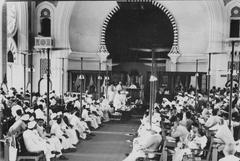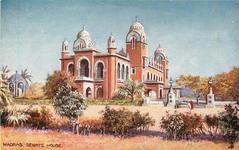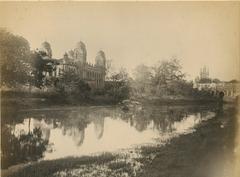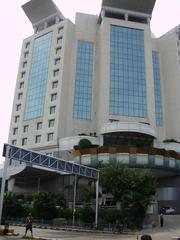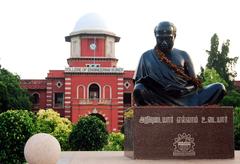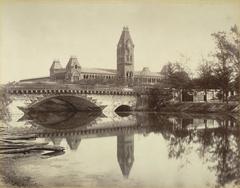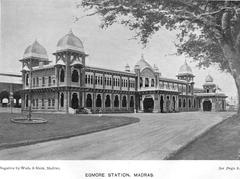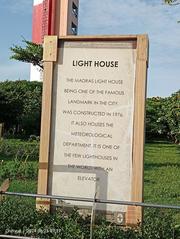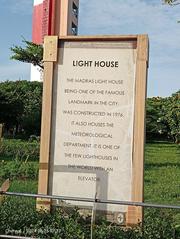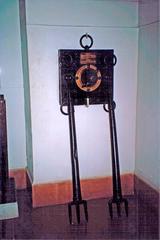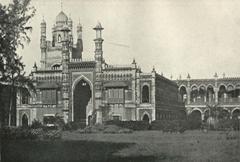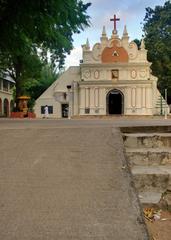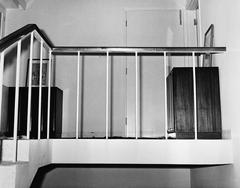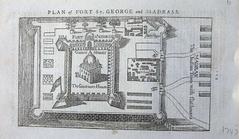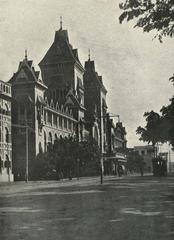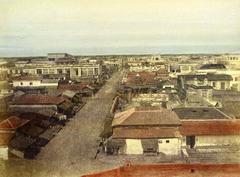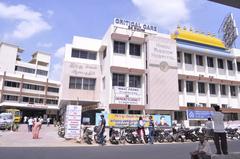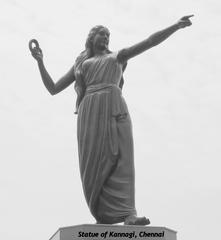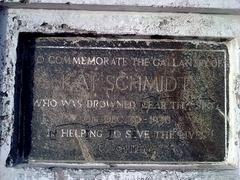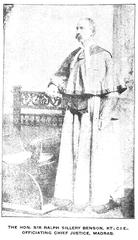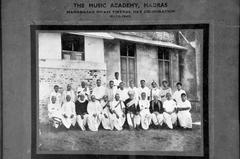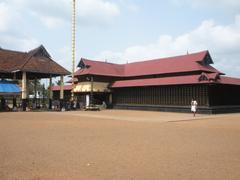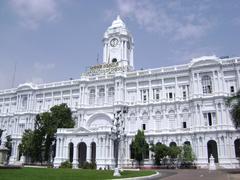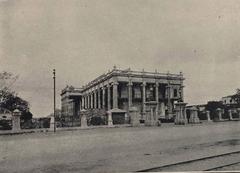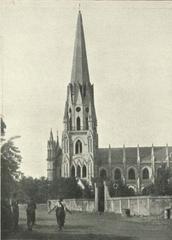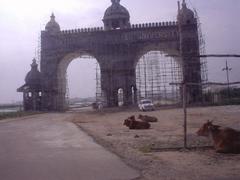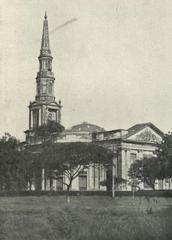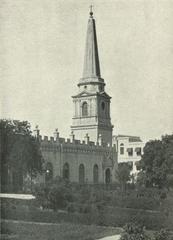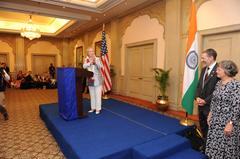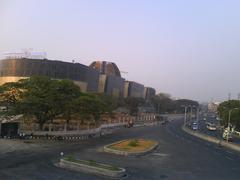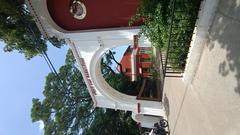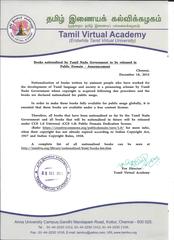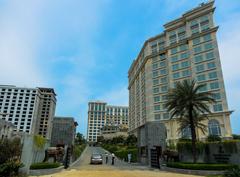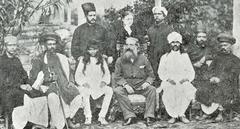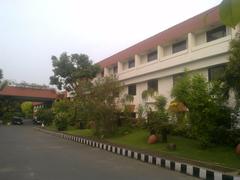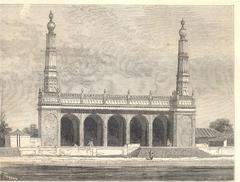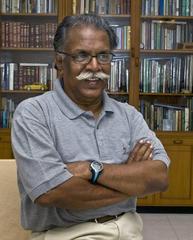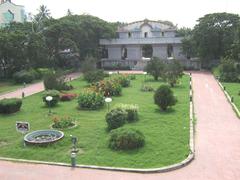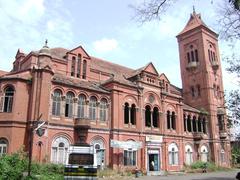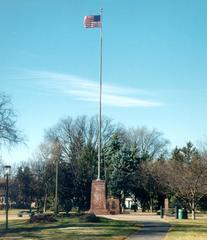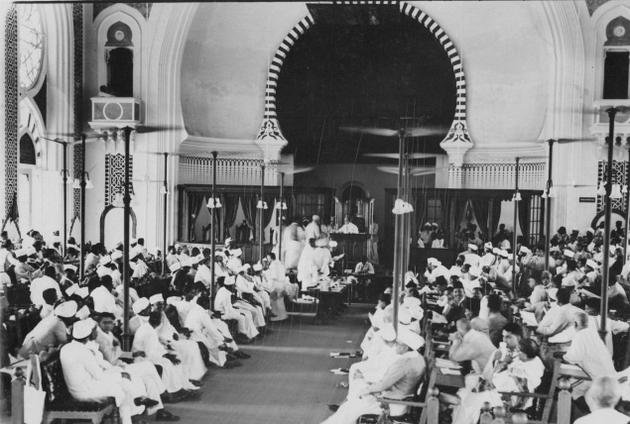
Senate House Chennai Visiting Hours, Tickets, and Historical Significance Guide
Date: 14/06/2025
Introduction
The Senate House, nestled within the University of Madras campus in the heart of Chennai, stands as a monumental testament to the city’s colonial legacy, architectural brilliance, and enduring cultural significance. Built between 1874 and 1879 by renowned British architect Robert Fellowes Chisholm, this iconic structure is a flagship example of Indo-Saracenic architecture—a unique blend of Indian, Islamic, and Gothic revival styles. Originally constructed as the administrative and ceremonial heart of the University of Madras, the Senate House has been a witness to pivotal moments in India’s history, including Mahatma Gandhi’s 1927 address and its role during the country’s freedom movement.
Today, the Senate House remains a vibrant venue for academic convocations, cultural festivals such as the Chennai Photo Biennale, and public events, reflecting its continued relevance in Chennai’s civic life. Visitors can explore this architectural marvel during special events, often enjoying free or nominally ticketed access, with guided tours offering deeper insight into its rich heritage and architectural features. Its strategic location near other notable attractions like Marina Beach and Fort St. George makes the Senate House a must-visit site for history enthusiasts and travelers alike. Up-to-date visiting information is available through official sources such as the University of Madras and Tamil Nadu Tourism (Tamil Nadu Tourism, University of Madras, Chennai Photo Biennale).
Quick Guide: Contents
- Origins and Architectural Context
- Colonial and Educational Role
- Political Significance
- Cultural and Symbolic Importance
- Post-Independence Evolution
- Visiting Hours, Tickets & Practical Tips
- Nearby Attractions & Travel Advice
- Preservation and Public Engagement
- Legacy and Continuing Impact
- Frequently Asked Questions (FAQ)
Origins and Architectural Context
Senate House was conceived and constructed in the late 19th century as the ceremonial and administrative core of the University of Madras, one of India’s oldest universities (est. 1857). Designed by Robert Fellowes Chisholm, a pioneer of Indo-Saracenic architecture, the building represents a fusion of Indian, Islamic, and European (notably Gothic) design elements. The result is a visually striking structure featuring grand domes, arches, stained glass, and ornamental plasterwork (Tamil Nadu Tourism).
Chisholm’s vision was not only to create an academic edifice but also to symbolize the aspirations and authority of the British colonial administration. The building’s architectural grandeur conveyed a sense of permanence and imperial ambition, while its function—hosting the University Senate—underscored the colonial government’s strategy of using higher education as a means of governance and cultural influence.
Colonial and Educational Role
During the British Raj, Senate House was more than just an academic venue. It served as the seat of the University Senate, responsible for overseeing academic curricula, policies, and degree conferment. The decisions made within its majestic halls shaped the development of higher education in southern India for generations to come (Tamil Nadu Tourism).
The architectural splendor of Senate House was intended to reflect both the power of the colonial regime and its commitment to fostering a Western-style educational system. This dual role placed the building at the intersection of political authority and cultural transformation.
Political Significance
Senate House is deeply woven into the fabric of India’s freedom movement. In 1927, Mahatma Gandhi addressed the All India Congress Committee here, galvanizing support for independence. The building also played a role during the Quit India Movement: Jawaharlal Nehru, who would become India’s first Prime Minister, was reportedly detained here while attempting to leave India in 1942. These moments transformed Senate House from a symbol of colonial authority into a site of national resistance and political activism (Tamil Nadu Tourism).
Cultural and Symbolic Importance
The Senate House is a repository of art, sculpture, and frescoes that celebrate India’s artistic traditions and narratives. Its Indo-Saracenic style, with vibrant stained glass, domes, and ornamental features, symbolizes the hybrid cultural identity of colonial-era Madras. The continued use of Senate House for academic, cultural, and public events highlights its ongoing role as a space for dialogue, exchange, and celebration of Chennai’s heritage.
Post-Independence Evolution
After 1947, Senate House retained its central role as the University of Madras’s ceremonial heart. Its large conference hall, capable of seating up to 1,500 people, became a popular venue for convocations, academic conferences, and public lectures (Tamil Nadu Tourism). The building’s complex now includes a library and restaurant, and its gardens offer a peaceful retreat from the city’s hustle.
Visiting Senate House Chennai: Hours, Tickets & Visitor Tips
Visiting Hours & Tickets (as of June 2025)
- Regular Access: Senate House is not open for daily public visits. Entry is available during special events, exhibitions, and festivals, such as the Chennai Photo Biennale.
- Hours: Event visiting hours typically run from morning to early evening, but always confirm with the event organizer or University of Madras website.
- Tickets: Admission is usually free or requires a nominal fee during special exhibitions. There are no routine ticket sales for daily tours.
Accessibility
- Ramps and accessible pathways are available at the main entrance, though some interior areas may have steps or uneven flooring. Visitors with mobility needs should contact event organizers or the university in advance.
- Photography is generally permitted in exterior areas and during exhibitions, though flash and tripods may be restricted indoors.
Travel Tips
- Transport: The Senate House is easily accessible by metro (Government Estate Metro Station, ~1 km), city buses, auto-rickshaws, and taxis. Parking is limited; public transport is recommended.
- Dress Code: Modest attire is advised, especially during university or cultural events.
- Timing: Early morning or late afternoon visits are best for avoiding crowds and enjoying optimal lighting for photos.
- Facilities: Restrooms are available on campus; cafes and restaurants are nearby along Marina Beach Road.
Nearby Attractions
- Marina Beach: The second-longest urban beach in the world, perfect for leisure walks.
- Fort St. George: The first British fortress in India, now housing a museum and government offices.
- Kapaleeswarar Temple: An iconic Dravidian temple in Mylapore.
- Government Museum Chennai: Extensive collections of South Indian art and archaeology.
- Higginbotham’s Bookstore: India’s oldest bookstore on Anna Salai (Fodor’s).
Preservation and Public Engagement
Extensive restoration, completed in 2006 by INTACH and the Archaeological Survey of India, stabilized the structure and conserved its frescoes and stained glass. Today, Senate House stands as a protected heritage site, hosting exhibitions and events like the Chennai Photo Biennale (The Hindu). Heritage walks and guided tours are offered during special events, providing in-depth historical and architectural insights.
Legacy and Continuing Impact
Senate House endures as a living monument to Chennai’s layered history and cultural vibrancy. From its colonial origins to its role in India’s freedom struggle and its present-day function as a hub for academic and cultural gatherings, the building encapsulates Chennai’s journey from imperial outpost to modern metropolis. Its architectural beauty, political legacy, and cultural resonance make it an essential stop for those seeking to understand the city’s past and present (Tamil Nadu Tourism).
Frequently Asked Questions (FAQ)
Q: What are the Senate House Chennai visiting hours?
A: Senate House is generally open to the public only during special events and exhibitions. Check the University of Madras or event organizer’s website for up-to-date schedules.
Q: Is there an entry fee?
A: Entry is usually free, but some events or guided tours may require a nominal fee.
Q: Are guided tours available?
A: Guided tours are occasionally offered during exhibitions or by prior arrangement with the university.
Q: Is the Senate House accessible for differently-abled visitors?
A: The main entrance is accessible, but some interior areas may not be fully barrier-free. Contact the university or organizers in advance for specific needs.
Q: What other attractions are nearby?
A: Marina Beach, Fort St. George, Government Museum, and Kapaleeswarar Temple are all close to Senate House.
Recommendations for a Memorable Visit
- Plan Ahead: Time your visit to coincide with cultural events or festivals for access to the interiors.
- Join Heritage Walks: Many local groups organize walks covering Senate House and neighboring colonial-era landmarks.
- Stay Informed: Follow the University of Madras and Chennai Photo Biennale for event updates.
- Use Public Transport: Parking is limited, so metro, buses, or taxis are best.
- Explore Nearby: Combine your visit with other Chennai heritage sites for a full day of discovery.
Conclusion
The Senate House Chennai is more than an architectural marvel—it is a living, vibrant heritage site that encapsulates the city’s journey through colonial history, freedom struggles, and cultural revival. While regular daily access remains limited, special events open its doors to the public, offering rare opportunities to experience its grandeur firsthand. Plan your visit around these occasions and enhance your Chennai itinerary with nearby historical landmarks. For the latest updates, ticketing information, and event schedules, consult official channels and consider downloading the Audiala app for curated guides and notifications.
References and Useful Links
- Senate House Chennai – Tamil Nadu Tourism
- Senate House Chennai – Fodor’s Architectural Highlights
- University of Madras – Senate House
- Senate House Events – The Hindu
- Chennai Photo Biennale Official Site
Ready to explore Chennai’s architectural treasures? Download the Audiala app for up-to-date travel guides, event alerts, and exclusive insights. Follow us on social media, and share your experiences to inspire fellow travelers.
